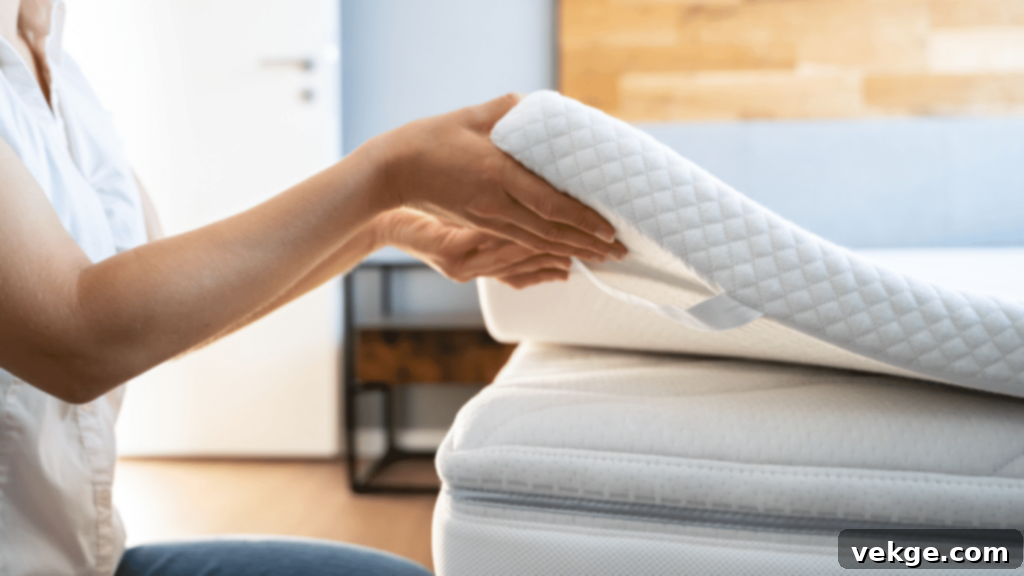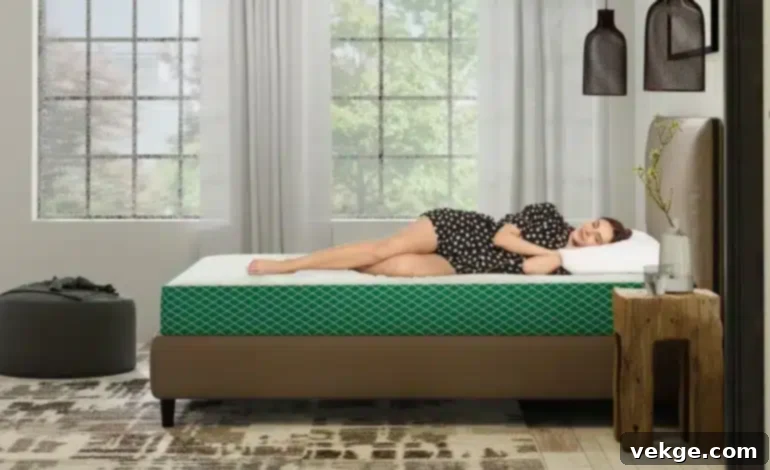The Ultimate Guide to Choosing Your Perfect Mattress: Enhance Your Sleep & Well-being
Finding the perfect mattress is a cornerstone of a healthy lifestyle, essential for ensuring a rejuvenating night’s sleep and fostering overall well-being. Far more than just a place to rest, a high-quality mattress plays a crucial role in alleviating discomfort, providing correct body support, and significantly boosting your sleep quality. Investing in the right mattress is an investment in your health, energy levels, and daily productivity.
This comprehensive guide is designed to empower you with the knowledge needed to make an informed decision. We will delve into the critical factors to consider when selecting a mattress, highlight the profound benefits of choosing a quality sleep surface, and help you understand how the right mattress can transform your nightly rest and, by extension, your entire life.
Here’s everything you need to know to make an informed choice:
1. Understand Your Unique Sleep Needs for Optimal Comfort

The journey to finding your ideal mattress begins with a thorough understanding of your personal sleep requirements. Your individual preferences, sleeping habits, and any existing health concerns are paramount in guiding your selection process. Each person’s body is unique, and what works for one may not work for another.
- Sleeping Position: Your primary sleeping position is perhaps the most critical factor in determining the appropriate mattress firmness and type.
- Side Sleepers: Individuals who sleep on their side often require a softer mattress. This allows for adequate cushioning around pressure points like the shoulders and hips, preventing discomfort and promoting proper spinal alignment. A medium-soft to soft mattress can contour to the body’s curves, distributing weight evenly and reducing the risk of aches and pains upon waking.
- Back Sleepers: For back sleepers, a medium-firm mattress is generally recommended. This level of firmness provides robust support to maintain the natural curvature of the spine, ensuring proper alignment without creating uncomfortable gaps or excessive sinking. It balances support with a touch of cushioning to keep the spine in a neutral position.
- Stomach Sleepers: Stomach sleepers typically benefit from a firmer mattress. A firm surface helps prevent the hips from sinking too deeply into the mattress, which can hyperextend the spine and lead to lower back pain. Maintaining a flatter, more even plane is crucial for stomach sleepers to avoid spinal misalignment.
- Combination Sleepers: If you frequently change positions throughout the night, a medium-firm mattress or a responsive hybrid option might be best. These mattresses offer a versatile balance of support and comfort, allowing for easy movement while still providing pressure relief.
- Health Considerations: Any existing health conditions should heavily influence your mattress choice, as the right support can significantly alleviate symptoms.
- Chronic Back Pain: If you suffer from chronic back pain or sciatica, a mattress that offers superior support and maintains proper spinal alignment is non-negotiable. Memory foam mattresses or hybrid mattresses with targeted supportive layers are often recommended for their ability to cradle the body and relieve pressure without sacrificing support. Look for zoned support systems that offer varying firmness levels for different body parts.
- Joint Issues or Arthritis: For those with joint pain or arthritis, a mattress that conforms closely to your body and effectively relieves pressure points can provide immense comfort. Memory foam or certain hybrid mattresses excel in this area, distributing body weight evenly to reduce stress on sensitive joints.
- Allergies: If you have allergies to materials such as latex or synthetic foams, it’s crucial to scrutinize the mattress’s composition. Hypoallergenic options, often made with natural latex or specific types of memory foam, can help minimize allergen exposure and promote healthier breathing during sleep. Additionally, look for mattresses with removable, washable covers.
- Temperature Regulation: If you tend to sleep hot, consider mattresses with cooling technologies such as gel-infused memory foam, open-cell foam structures, or breathable natural latex. Hybrid mattresses also tend to offer better airflow due to their coil layers.
2. Benefits of Investing in Quality Mattresses: Beyond Just Sleep
Quality mattresses are not merely about comfort; they represent a holistic approach to sleep health, renowned for their sophisticated blend of supportive engineering and luxurious comfort. They stand out as a superior choice in the crowded mattress market due to their thoughtful design and durable construction.
- Advanced Hybrid Design: Many top-tier mattresses feature a sophisticated hybrid design, which masterfully combines the best attributes of different mattress types. This typically involves layers of advanced memory foam paired with a robust system of individually wrapped innerspring coils.
- Contouring Comfort: The memory foam layer is engineered to adapt precisely to your body’s unique shape, offering unparalleled pressure relief. This adaptive quality helps to cushion sensitive areas, reduce tossing and turning, and ensure a comfortable, personalized sleep surface.
- Durable Support: Beneath the foam lies a layer of pocketed innerspring coils. These coils provide dynamic support, reacting independently to your body’s movements and weight. They enhance the mattress’s durability, help maintain its structural integrity over time, and prevent sagging. The coil system also promotes excellent airflow, which is crucial for temperature regulation, preventing heat buildup often associated with traditional memory foam.
- Motion Isolation: Individual coils also excel at isolating motion. This means that if you share your bed, movements from your partner are less likely to disturb your sleep, contributing to uninterrupted rest.
- Optimal Comfort and Support Balance: Quality mattresses are meticulously engineered to achieve a perfect equilibrium between plush comfort and essential support.
- Pressure Point Relief: The memory foam layers deliver a plush, conforming feel, effectively relieving pressure points across your body. This is particularly beneficial for individuals with joint pain, fibromyalgia, or back discomfort, as it minimizes strain and promotes better blood circulation.
- Spinal Alignment: The underlying coil system provides the necessary foundational support, ensuring your spine remains naturally aligned throughout the night. Proper spinal alignment is vital for preventing back pain, improving posture, and ensuring that your muscles can fully relax and recover. This balance leads to deeper, more restorative sleep.
- Enhanced Durability: High-quality materials and construction mean these mattresses retain their supportive and comfortable properties for longer, offering a consistent sleep experience year after year. This reduces the need for frequent replacements, making them a wise long-term investment.
Brands like Dreamcloud exemplify the features mentioned above, consistently providing ultimate comfort and superior support. If you’re wondering who sells Dreamcloud mattresses, they are widely available through a network of authorized online retailers and physical stores. This widespread availability ensures it’s easier than ever to find a Dreamcloud mattress that perfectly suits your specific needs, preferences, and budget, allowing you to experience the benefits of a premium sleep surface.
3. Types of Mattresses: A Comprehensive Overview for Every Sleeper

Understanding the distinct characteristics of various mattress types is fundamental to making an informed decision that aligns with your specific sleep preferences, health needs, and budget. Each type offers a unique feel and set of benefits.
- Innerspring Mattresses: These are the most traditional type of mattress, built around a core of steel coils that provide the primary support.
- Construction: Innerspring mattresses use a network of coils (such as Bonnell, offset, continuous, or individually pocketed coils) for their core support system. The number and gauge of these coils significantly influence the mattress’s feel and durability.
- Feel: They typically offer a firmer, more bouncy feel and excellent breathability due to the open structure of the coils.
- Advantages: Known for their affordability, good edge support (especially with reinforced edges), and excellent airflow, which helps prevent heat buildup. They are durable and offer a classic sleep experience.
- Disadvantages: May lack the contouring comfort and pressure relief of foam mattresses, and older models can be prone to motion transfer and sagging over time if coil quality is poor.
- Memory Foam Mattresses: Renowned for their body-conforming properties, memory foam mattresses have become a popular choice for pressure relief.
- Construction: Made from viscoelastic foam, which softens in response to body heat and pressure, allowing it to mold closely to the sleeper’s shape. Modern memory foam mattresses often feature multiple layers of different foam densities for support and comfort.
- Feel: Offers exceptional comfort, a “hugging” sensation, and superior pressure-relieving qualities. They are excellent at motion isolation, making them ideal for couples.
- Advantages: Alleviate pressure points, promote spinal alignment, and significantly reduce motion transfer. Many modern memory foam mattresses incorporate cooling elements (like gel infusions, copper, or open-cell structures) to mitigate traditional heat retention issues.
- Disadvantages: Can sometimes trap heat (though newer models address this), may have a slower response time to movement, and some users dislike the “sinking in” feeling.
- Hybrid Mattresses: Representing the best of both worlds, hybrid mattresses combine different technologies to offer a balanced sleep experience.
- Construction: These mattresses typically feature a base of individually wrapped innerspring coils for support, topped with comfort layers of memory foam, latex, or other specialized foams.
- Feel: Designed to provide the contouring benefits and pressure relief of foam with the robust support, bounce, and breathability of coils.
- Advantages: Offer a versatile choice for many sleepers, providing excellent support, pressure relief, good motion isolation, and enhanced airflow compared to all-foam beds. They come in a wide range of firmness levels and feel profiles.
- Disadvantages: Can be heavier and more expensive than single-type mattresses due to their complex construction.
- Latex Mattresses: A durable and often natural alternative, latex mattresses are celebrated for their responsive feel and eco-friendly properties.
- Construction: Made from natural or synthetic latex. Natural latex comes from rubber trees and is processed using Dunlop or Talalay methods, resulting in different feels.
- Feel: They offer a firm, buoyant, and highly responsive feel – you sleep “on” the mattress rather than “in” it. They are known for their exceptional durability and elasticity.
- Advantages: Highly durable, hypoallergenic, resistant to dust mites and mold, and generally more breathable than traditional memory foam. Natural latex is an eco-friendly choice. They provide excellent support and pressure relief.
- Disadvantages: Can be more expensive than other types, and their heavier weight can make them difficult to move. Some find the bouncy feel not to their preference.
4. Mattress Firmness: Navigating the Scale for Your Perfect Match
Choosing the correct mattress firmness level is a highly personal decision that profoundly impacts your comfort, support, and overall sleep quality. The ideal firmness prevents pressure points and ensures proper spinal alignment.
- Soft Mattresses (1-3 on a 1-10 scale):
- Feel: Provide a plush, deeply conforming feel, often described as “sleeping in” the mattress. They offer a luxurious, cloud-like sensation.
- Ideal For: Primarily suited for side sleepers who need extra cushioning for their shoulders and hips to prevent pressure buildup. Lighter individuals (under 130 lbs) may also find soft mattresses more comfortable, as they don’t exert enough pressure to sink into firmer options. They are also suitable for those who enjoy a more enveloping, “hug” like feel.
- Benefits: Excellent pressure relief, especially for sensitive joints.
- Considerations: May not provide adequate support for back or stomach sleepers, potentially leading to spinal misalignment and back pain. Can make it harder to move around or get out of bed for some individuals.
- Medium-Firm Mattresses (4-7 on a 1-10 scale):
- Feel: Offer a balanced blend of support and comfort. They provide some cushioning without allowing the body to sink too deeply.
- Ideal For: Highly versatile and work well for back sleepers, combination sleepers, and couples with different sleep preferences. They provide adequate support to maintain spinal alignment while also offering sufficient cushioning for pressure relief. This is often the most popular firmness choice due to its adaptability.
- Benefits: Good all-around support, balanced pressure relief, and ease of movement. Often a good compromise for couples with differing firmness preferences.
- Considerations: Might still be too soft for heavier stomach sleepers or too firm for very lightweight side sleepers.
- Firm Mattresses (8-10 on a 1-10 scale):
- Feel: Provide a solid, unyielding surface. You typically sleep “on” a firm mattress rather than sinking into it.
- Ideal For: Generally preferred by stomach sleepers who need to keep their hips elevated to prevent back pain, as well as heavier individuals (over 230 lbs) who require extra support to maintain proper spinal alignment. Some back sleepers who prefer a very stable surface also opt for firm mattresses.
- Benefits: Helps prevent the body from sinking too deeply, which can reduce the risk of back pain for certain sleep positions and body types. Offers excellent foundational support.
- Considerations: Can create pressure points for side sleepers or lighter individuals. Some people might find them too hard, leading to discomfort rather than relief.
- Body Weight and Firmness: It’s important to note that perceived firmness can vary based on an individual’s body weight. A mattress that feels firm to a lightweight person might feel medium to a heavier person. Always consider your body type when evaluating firmness levels.
5. Mattress Size: Finding the Perfect Fit for Your Space and Lifestyle

Selecting the appropriate mattress size is not just about comfort; it’s also crucial for optimizing your bedroom space and accommodating your sleeping habits, whether you sleep alone, with a partner, or even with pets and children.
- Twin (38″ x 75″):
- Ideal For: Children, teenagers, and single adults in smaller rooms or studio apartments. They are also common for bunk beds and daybeds.
- Considerations: Provides adequate space for single sleepers but may be too short or narrow for taller adults or those who tend to spread out.
- Twin XL (38″ x 80″):
- Ideal For: Taller single adults, especially popular in college dorm rooms. Offers the same width as a Twin but with an extra 5 inches in length.
- Considerations: Good for individuals over 6 feet tall who need more legroom.
- Full / Double (54″ x 75″):
- Ideal For: Single adults who desire more room than a Twin to spread out, or for couples who prefer a cozier sleeping arrangement in a smaller bedroom.
- Considerations: While called a “double,” it can be quite tight for two adults, offering only 27 inches of width per person – less than a Twin. Best for one adult or occasional guest use.
- Queen (60″ x 80″):
- Ideal For: The most popular mattress size, providing ample space for most couples and individuals who prefer extra room to stretch out. Fits comfortably in most standard bedrooms (at least 10×10 feet).
- Considerations: Offers a good balance of space and affordability, making it a versatile choice for many households.
- King (76″ x 80″):
- Ideal For: Couples who desire maximum personal sleeping space, or those who frequently share their bed with children or pets. It offers the same length as a Queen but significantly more width.
- Considerations: Requires a larger bedroom (at least 12×12 feet) to accommodate it comfortably without making the room feel cramped. Provides each sleeper with the equivalent space of a Twin XL mattress.
- California King (72″ x 84″):
- Ideal For: Taller individuals or couples who need extra length, as it is 4 inches longer but 4 inches narrower than a standard King. Perfect for those over 6’4″ or people with very tall pets.
- Considerations: Also requires a larger bedroom. Offers a slightly different footprint than a King, so measure your space carefully.
6. Mattress Materials and Construction: Deciphering Quality and Performance
The internal materials and construction methods of a mattress are pivotal to its comfort, durability, and overall long-term performance. A deeper understanding of these elements will empower you to make a truly informed and satisfactory choice, ensuring your investment delivers years of restful sleep.
- High-Quality Materials: The longevity and comfort of a mattress are intrinsically linked to the quality of its components.
- Foam Density and Type: For memory foam and polyfoam layers, look for higher density foams (e.g., 3-5 lbs/cu ft for memory foam). Higher density generally indicates better durability and support, reducing the risk of premature sagging. Also, consider the type of foam – gel-infused, open-cell, or copper-infused foams can improve temperature regulation. Look for CertiPUR-US certification for foams, ensuring they are free from harmful chemicals.
- Natural Latex: If choosing a latex mattress, prioritize natural latex (Dunlop or Talalay) for its exceptional durability, responsiveness, and hypoallergenic properties. It’s also an eco-friendly option. Look for GOLS (Global Organic Latex Standard) certification.
- Premium Coils: In innerspring and hybrid mattresses, the quality of the coils is paramount. Individually wrapped (pocketed) coils offer superior motion isolation and contouring compared to interconnected coils. Look for coil gauge (lower numbers mean thicker, firmer coils) and the total coil count (higher count generally means more support points).
- Cover Materials: The mattress cover (ticking) also contributes to comfort and breathability. Materials like organic cotton, Tencel, or bamboo are often more breathable, softer, and more environmentally friendly than synthetic blends.
- Advanced Construction: A mattress’s construction dictates how it feels, performs, and lasts. Pay attention to these key structural features:
- Layering: A well-constructed mattress typically features multiple layers of different materials, each serving a specific purpose (e.g., a soft comfort layer on top, a firmer transition layer, and a robust support core). The thoughtful arrangement of these layers contributes to balanced support and pressure relief.
- Edge Support: Robust edge support is crucial, especially for couples or those who tend to sleep near the edge of the bed. Stronger edges prevent the mattress from collapsing when you sit on it or sleep close to the perimeter, maximizing the usable sleep surface and extending the mattress’s lifespan. This is often achieved through reinforced foam perimeters or stronger coils around the edge.
- Zoned Support Systems: Some premium mattresses incorporate zoned support, meaning different areas of the mattress have varying levels of firmness or coil density. This provides targeted support for heavier parts of your body (like hips and shoulders) and softer support for lighter areas, promoting optimal spinal alignment and pressure relief.
- Motion Isolation: For partners, excellent motion isolation is a must-have. Individually pocketed coils and high-density memory foam are particularly effective at absorbing movement, ensuring that one partner’s tossing and turning doesn’t disturb the other.
- Durability and Longevity: High-quality materials and meticulous construction contribute directly to a mattress’s lifespan. Look for generous warranties (10 years or more) as an indicator of a manufacturer’s confidence in their product’s durability.
- Certifications: Beyond CertiPUR-US for foams, look for other certifications like OEKO-TEX (for textiles) or GOTS (Global Organic Textile Standard) for organic materials, ensuring the mattress meets stringent health and environmental standards.
Selecting the perfect mattress is a significant decision that profoundly impacts your restful night’s sleep and overall daily well-being. By thoroughly understanding your unique sleep needs, exploring the diverse range of mattress types available, and carefully considering crucial factors such as materials, construction quality, firmness levels, and size, you can make a truly informed and beneficial decision.
Modern mattresses, particularly those featuring a thoughtful blend of memory foam for contouring comfort and supportive innerspring coils for robust structure, offer an exceptional combination of pressure relief and foundational support. With the vast array of high-quality options now readily available on the market, finding one that precisely suits your individual requirements and preferences has never been easier. Investing in the right mattress is an investment in your health, ensuring you’ll not only get consistently better sleep but also wake up feeling refreshed, energized, and ready to tackle each new day with vitality.
